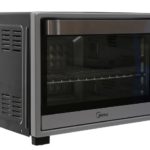Modern life has made the oven a common appliance in every family kitchen. However, many people struggle with the problem of uneven heating in their ovens and are unsure how to address it. In this article, we will explore this issue and provide some helpful solutions.
1 Issues with oven’s uneven heating
Uneven heating in an oven refers to a situation where the actual temperature inside the oven does not match the temperature set on the machine. This inconsistency can make baking cakes a challenging task.
If you use the wrong temperature and time to bake a cake, you may encounter the following situations:
- Low temperature: The cake’s surface will be light yellow, and the texture will be dry and hard instead of soft and fluffy. The inside of the cake may still be dense, moist, and elastic.
- Insufficient baking time + low temperature: In this case, the cake will resemble an undercooked cake, lacking the beautiful yellow color and with a lingering smell of raw eggs.
- Insufficient baking time: The cake will rise normally, and the outside will be nicely yellow. However, once taken out of the oven, the cake will deflate, and the inside will remain moist.
- High heat inside the oven + insufficient baking time: The cake’s surface may crack and burn. Although the surface may feel dry when tested with a toothpick, the cake will flatten or shrink upon removal due to the inside’s incomplete dryness.
- Excessive heat or fire: The high temperature causes the rapid expansion of gas inside the cake. As a result, the cake’s structure collapses and loses its stability.
 Issues when the oven is unevenly heated
Issues when the oven is unevenly heated
2 How to resolve uneven heating in the oven
Use an oven thermometer
Using an oven thermometer is an effective way to determine the actual temperature inside the oven and evaluate its heating stability. By measuring and recording the temperature throughout the baking process, you can identify temperature variations and assess the oven’s consistency.
- Unevenly distributed temperature: If certain areas of the oven are hotter than others, you can rotate the baking tray after 1/3 or 2/3 of the baking time to ensure even cooking.
- Different temperature between top and bottom: If your oven’s top heating element is hotter than the bottom one, you can change the position of the baking tray.
- Difference between set and actual temperature: Adjust the baking method and external control knob to achieve the desired oven temperature.
If you notice that the cake is browning too quickly in a particular area, you can cover that area with foil after approximately 1/2 or 2/3 of the baking time to prevent burning or overcooking.
 Using an oven thermometer
Using an oven thermometer
Adjust the position of the baking tray
When baking in an unstable oven, it is crucial to monitor the rising speed and doneness of the cake and other foods. If you observe uneven cooking, you can change the position of the baking tray to move the undercooked part to a hotter area in the oven.
However, keep in mind that this can result in a sudden and significant reduction in oven temperature. Therefore, act quickly to minimize the time the oven door is open and reduce the internal temperature. Ensure that the cake and other foods are baked evenly by observing and acting promptly.
 Change the position of the baking tray
Change the position of the baking tray
Choose the appropriate oven size and cake mold
If you use a 20cm round cake mold with a height of 8cm in a small oven, the top and bottom of the mold will be closer to the heating element. This proximity can result in the cake being cooked and browned faster than expected.
 Change the position of the baking tray
Change the position of the baking tray
Consider the color of the cake mold
The color of the cake mold can impact the heat transfer process and temperature difference during baking. Dark-colored molds tend to absorb and transfer heat faster than light-colored molds, causing a temperature difference of up to approximately 10 degrees.
For even heat distribution, ensure that all molds inside the oven have the same color.
 Choose the color of the cake mold
Choose the color of the cake mold
These are some tips to help you address the issue of uneven heating in your oven. Explore more articles from us for additional kitchen tips!



































